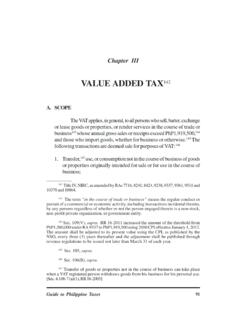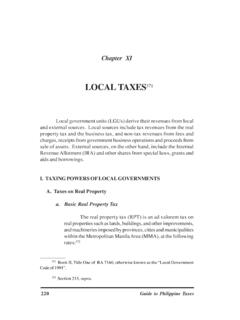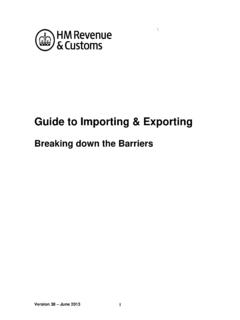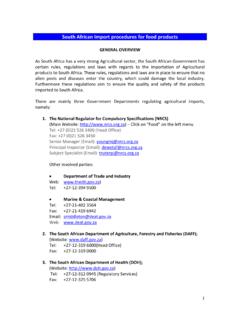Transcription of TARIFF AND CUSTOMS DUTIES - ntrc.gov.ph
1 Chapter VII. TARIFF AND CUSTOMS DUTIES . A. IMPORT DUTIES . 1. Ordinary Import DUTIES TARIFF DUTIES are levied on imported goods either as a revenue generating measure or a protective scheme to artificially or temporarily inflate prices to support the local industries of a particular country and protect its domestic output from their foreign counterparts. In the Philippines, import DUTIES are imposed, generally in ad valorem form, on articles entering the country in accordance with their corresponding schedules and classifications as provided under Section 104 of the TARIFF and CUSTOMS Code of the Philippines (TCCP) of 1978, as amended. With the exception of certain articles which can be imported duty-free, upon compliance with certain prescribed conditions or formalities317, goods are levied import DUTIES depending on the trade agreements, regional groupings, among others. As per the TCCP, the rate of duty classification can either be EO 22. Most Favoured Nation or MFN or ASEAN Trade in Goods Agreement (ATIGA).
2 Under the MFN treatment,318 the rate of duty ranges from Free/Zero to 30% except in cases of sensitive agricultural 317. Section 105 (Conditionally-Free Importations), TCCP, as amended. 318. It is the basic Philippine rate of duty applicable to imports coming from non- ASEAN Members. 158 Guide to Philippine Taxes Chapter VII TARIFF and CUSTOMS DUTIES products which are accorded a certain degree of protection via higher TARIFF rates reaching to as high as 65%319. On the other hand, under the ATIGA320, Member States agreed to place 99% of all the products in their Inclusion List (IL) at zero-duty. In compliance with ATIGA, the Philippines implemented its TARIFF commitments, the last tranche of which was made via Executive Order (EO) No. 850 (implemented on January 1, 2010)321. Thus, most goods from the ASEAN are levied ordinary import DUTIES of 0%322. 319. The 65% rate of duty is levied on out-quota importations of cane sugar under Subheading and certain other TARIFF lines under the Hdg.
3 No. 1701. Subheading shall cover only cane sugar obtained without centrifugation, whose content of sucrose by weight, in the dry state, corresponds to a polarimeter reading of 69o or more but less than 93o. The said product contains only natural anhedral microcrystals, of irregular shape, not visible to the naked eye, which are surrounded by residues of molasses and other constituents of sugar cane. The TARIFF and CUSTOMS Code of the Philippines (TCCP), as Amended ASEAN Harmonized TARIFF Nomenclature (AHTN) 2012. has indicated that the 65% duty for the said goods will be in force until 2015. However, as per verification from the TARIFF Commission, there are no recent issuances as to the modifications in the rates. Hence, the 65% rate of duty for the said goods shall remain in force and effect until further modifications. 320. ATIGA is an improvement over the CEPT (Common Effective Preferential TARIFF Scheme) AFTA. It consolidates ASEAN's existing initiatives, obligations and commitments made with regard to both Trade in Goods ( tariffs ) and non- TARIFF elements ( , trade disciplines on Sanitary and Phytosanitary (SPS) measures, CUSTOMS procedures, and trade facilitations), among others into one comprehensive agreement.
4 It includes an effective TARIFF preferential to ASEAN, to be applied to goods originating from ASEAN Member States ( , Brunei Darussalam, Cambodia, Indonesia, Lao PDR, Malaysia, Philippines, Singapore, Thailand, and Vietnam). 321. Member States of the ASEAN have agreed to maintain certain tariffs on selected items that make up their Sensitive/Highly Sensitive Lists which are subject to as high as 35% TARIFF DUTIES . The 40% rate of duty is effective until 2014 and will go down to 35% until 2015 ( rice under Hdg. No. ). As per verification from the TARIFF Commission, the 35% rate remains in force and effect for 2016 or until further modifications. 322. Member States shall eliminate import DUTIES on all products traded between the Member States by 2010 for ASEAN-6 (Brunei Darussalam, Indonesia, Malaysia, Philippines, Singapore, and Thailand) except those products where Member States invoked the protocol for special consideration, Philippines for some sugar products to be reduced to 28% in 2012, and will be further reduced to 18%, 10%, and 5% in 2013, 2014, and 2015, respectively, (EO 892 issued on June 17, 2010); and by 2015, with flexibility to 2018, for Cambodia, Lao PDR, Myanmar, and Vietnam (Article 19, ATIGA).
5 Guide to Philippine Taxes 159. Chapter VII TARIFF and CUSTOMS DUTIES The President, upon recommendation of the National Economic and Development Authority (NEDA), in the interest of national economy, general welfare, and/or national security, is empowered to increase, reduce, or remove existing protective TARIFF rates (including any necessary change in classification) but in no case shall the increased rate of duty be higher than a maximum of one hundred (100) per cent ad valorem; establish import quota and/or ban importation of any commodity, as may be necessary; and impose an additional duty on all imports not exceeding ten (10) per cent ad valorem323 whenever necessary. The President may also gradually reduce the said protection levels upon periodic investigations by the TARIFF Commission (TC) and as recommended by the NEDA. 1. Special DUTIES These are levied in addition to the ordinary import DUTIES , taxes and charges imposed by law on the imported product under the following circumstances: a.
6 Anti-Dumping Duty 324. The anti-dumping duty is a trade remedy measure adopted by the government to protect a domestic industry against the unfair trade practice of It is a special duty imposed in the event that a specific kind or class (any product, commodity, or article of commerce) of foreign article, 323. Section 401 (Flexible Clause), TCCP, as amended. 324. Provided under RA 8752 (August 12, 1999) Entitled, An Act Providing the Rules for the Imposition of an Anti-Dumping Duty, Amending for the Purpose Section 301, Part 2, Title II, Book I of the TARIFF and CUSTOMS Code of the Philippines, as amended by RA 7843, and for Other Purposes . 325. Anti-Dumping Measures: Primer, TARIFF Commission, viewed April 5, 2016, view?pref=2&pli=1 . 160 Guide to Philippine Taxes Chapter VII TARIFF and CUSTOMS DUTIES is being imported into, sold or is likely to be sold in the Philippines, at an export price less than its normal value in the ordinary course of trade for a like product, commodity or article destined for consumption in the exporting country which is causing or threatening to cause material injury to a domestic industry, or materially retarding the establishment of a domestic industry producing similar product.
7 This duty is imposed by the Secretary of Trade and Industry, in the case of non-agricultural products, commodities or articles, or the Secretary of Agriculture, in the case of agricultural products, commodities or articles, after formal investigation and affirmative finding of the TARIFF Commission of the said act. The duty is equal to the margin of dumping on such product, commodity or article and on like product, commodity or article thereafter imported into the Philippines under similar circumstances. However, the duty may be charged less than the margin of dumping if the said lesser duty is adequate to remove the injury to the local industry. The decision as to whether or not to impose a definitive anti- dumping duty even when the requirements for the imposition are met/fulfilled will remain the prerogative of the TC. It may take into consideration, among others, the effect of imposing an anti-dumping duty on the welfare of consumers and/or the general public, and other related local industries.
8 B. Countervailing Duty 326. The countervailing duty is a special duty charged whenever any product, commodity or article of commerce is granted directly or indirectly by the government in the country 326. Provided under RA 8751 (August 7, 1999) Entitled, An Act Strengthening the Mechanisms for the Imposition of Countervailing DUTIES on Imported Subsidized Products, Commodities or Articles of Commerce in Order to Protect Domestic Industries from Unfair Trade Competition, Amending for the Purpose Section 302, Part 2, Title II, Book I of Presidential Decree (PD) No. 1464, Otherwise Known as the TARIFF and CUSTOMS Code of the Philippines, As Amended . Guide to Philippine Taxes 161. Chapter VII TARIFF and CUSTOMS DUTIES of origin or exportation, any kind or form of specific subsidy upon the production, manufacture or exportation of such product, commodity or article, and the importation of such subsidized product, commodity or article has caused or threatens to cause material injury to a domestic industry or has materially retarded the growth or prevents the establishment of a domestic industry.
9 After formal investigation and affirmative finding by the TARIFF Commission of such threat, the countervailing duty which is equal to the ascertained amount of the subsidy, may be imposed by the Secretary of Trade and Industry, in the case of non-agricultural products, commodities or articles, or the Secretary of Agriculture, in the case of agricultural products, commodities or articles on like product, commodity or article thereafter imported into the Philippines. c. Marking Duty 327. The marking of articles (or its containers) is a prerequisite for every article or container of foreign origin which is imported into the Philippines in accordance with Section 303 of the TCCP. The marking shall be done in any official language of the Philippines and in a conspicuous place as legibly, indelibly and permanently as the nature of article (or container) may permit to indicate to an ultimate purchaser in the Philippines the country of origin of the article. In case of failure to mark an article or its container at the time of importation, unless otherwise excepted328 from the requirements of marking, there shall be levied upon such article a marking duty of 5% ad valorem.
10 327. Section 303, TCC, as amended. 328. Section 303(a)(3), TCC, as amended. 162 Guide to Philippine Taxes Chapter VII TARIFF and CUSTOMS DUTIES d. Discriminatory Duty329. As stipulated under Section 304 of the TCCP, the discriminatory duty is a new or additional duty in an amount not exceeding 100% ad valorem, imposed by the President by proclamation upon articles of a foreign country which discriminates against Philippine commerce or against goods coming from the Philippines in such manner as to place the commerce of the Philippines at a disadvantage compared with the commerce of any foreign country. e. General Safeguard Measure330. A general safeguard measure is applied by the Secretary of Trade and Industry (for non-agricultural products). or the Secretary of Agriculture (for agricultural products) upon positive final determination of the TARIFF Commission that a product is being imported into the country in increased quantities, whether absolute or relative to domestic production, as to cause or threaten to cause serious injury to the domestic industry.















